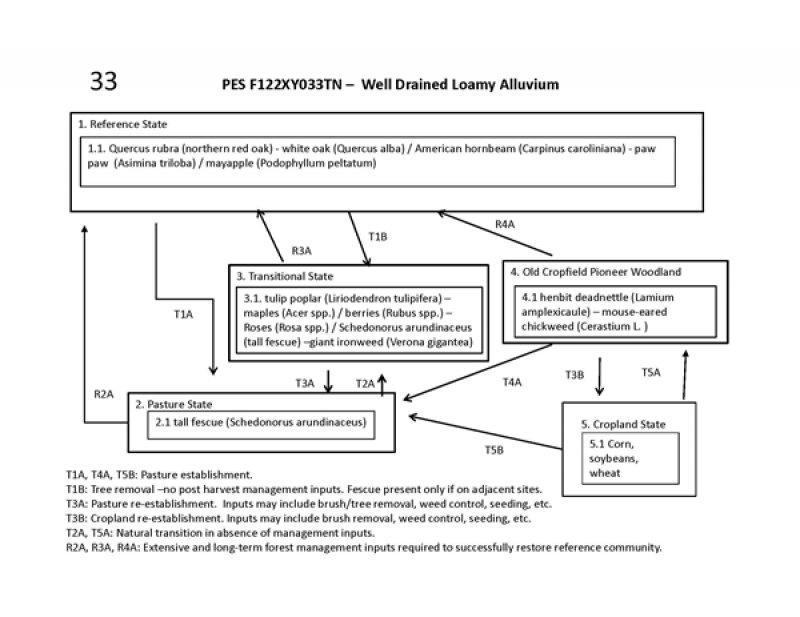
Natural Resources
Conservation Service
Ecological site F122XY033TN
Well Drained Loamy Alluvium
Last updated: 5/14/2025
Accessed: 12/07/2025
General information
Provisional. A provisional ecological site description has undergone quality control and quality assurance review. It contains a working state and transition model and enough information to identify the ecological site.
MLRA notes
Major Land Resource Area (MLRA): 122X–Highland Rim and Pennyroyal
MLRA 122 is in Tennessee (47 percent), Kentucky (43 percent), Indiana (7 percent), and Alabama (3 percent). It makes up about 21,530 square miles (55,790 square kilometers).
SOILS:
Many of the soils in this MLRA are Udalfs. The moderately deep to very deep, well drained, clayey soils formed in limestone residuum. They are dominantly in rolling to steep areas of the “Outer Basin” (Mimosa, Braxton, Gladdice, and Hampshire series) and the undulating to hilly areas of the “Inner Basin” (Talbott and Bradyville series). The most agriculturally productive soils are the very deep, well drained, clayey or loamy soils that formed in alluvium and/or loess over alluvium or limestone residuum in nearly level to undulating areas (Armour, Cumberland, Harpeth, Lomond, and Maury series). The less extensive soils generally are moderately well drained to somewhat poorly drained and formed in loamy or clayey alluvium and/or residuum (Byler, Capshaw, Colbert, and Tupelo series). This MLRA has a significant acreage of Mollisols. Shallow or moderately deep, well drained, clayey Udolls (Ashwood and Barfield series) formed in limestone residuum dominantly in rolling to steep areas. Very shallow, well drained, clayey Rendolls (Gladeville series) formed in limestone residuum dominantly in undulating to rolling areas of the “Inner Basin.” Very deep, well drained or moderately well drained Udolls (Arrington, Egam, Lynnville, and Staser series) and somewhat poorly drained or poorly drained Aquolls (Agee, Godwin, and Lanton series) formed in loamy or clayey alluvium derived from limestone on flood plains. Most of the remaining soils on flood plains are moderately well drained or well drained Udepts (Lindell and Ocana series). Udults are of small extent in this area. Most are very deep, well drained, and loamy and formed in gravelly colluvium or colluvium and the underlying residuum on steep hillsides (Dellrose soils). Rock outcrops are common on uplands.
BIOLOGICAL RESOURCES:
This area supports mixed oak forest vegetation. White oak, black oak, northern red oak, and some scarlet oak are the dominant tree species. Shagbark hickory, bitternut hickory, pignut hickory, and mockernut hickory also occur. Oak, blackgum, flowering dogwood, sassafras, Virginia pine, pitch pine, and shortleaf pine grow mostly on ridgetops.
(Excerpt from United States Department of Agriculture, Natural Resources Conservation Service. 2006. Land Resource Regions and Major Land Resource Areas of the United States, the Caribbean, and the Pacific Basin. U.S. Department of Agriculture Handbook 296.)
Classification relationships
NatureServe Scientific Name: South-Central Interior Large Floodplain -Unique Identifier: CES202.705
NatureServe Scientific Name: South-Central Interior Small Stream and Riparian- Unique Identifier: CES202.706
Ecological site concept
Only two tree species can be selected for entry into the ESIS/EDIT database as dominants; however, multiple tree species may be co-dominant on these sites. The NRCS county soil surveys list various hardwoods on site including northern red oak, white oak, cherrybark oak, tulip poplar, black walnut, and pines.
Ecological Dynamics:
State 1. Phase 1.1. (Reference): Forestland
Quercus rubra (northern red oak) - white oak (Quercus alba) / American hornbeam (Carpinus caroliniana) - paw paw (Asimina triloba) /
mayapple (Podophyllum peltatum)
State: 2. Phase 2.1. Pasture
Plant species dominant: Schedonorus arundinaceus (tall fescue)
Pasture plant species are dependent on management.
State: 3. Phase 3.1. Transitional Field
Plant species dominants: tulip poplar (Liriodendron tulipifera) – maples (Acer spp.) / berries (Rubus spp.) – Roses (Rosa spp.) / Schedonorus arundinaceus (tall fescue) –giant ironweed (Verona gigantea)
State 3 is typified by a variety of grasses, forbs, herbs, and young trees.
State 4: Phase 4.1. Abandoned Croplands
Plant species dominant:
henbit deadnettle (Lamium amplexicaule) – mouse-eared chickweed (Cerastium L. )
Many weeds, forbs, and grasses are possible in this state.
State 5.0. Phase 5.1. Cropland
Plant species dominants: dependent upon seeding and management. Most common crops are corn and soybeans.
Associated sites
| F122XY030TN |
Moderately Well Drained Loamy Alluvium Moderately Well Drained Loamy Alluvium |
|---|
Table 1. Dominant plant species
| Tree |
(1) Quercus rubra |
|---|---|
| Shrub |
(1) Carpinus caroliniana |
| Herbaceous |
(1) Podophyllum peltatum |
Click on box and path labels to scroll to the respective text.
